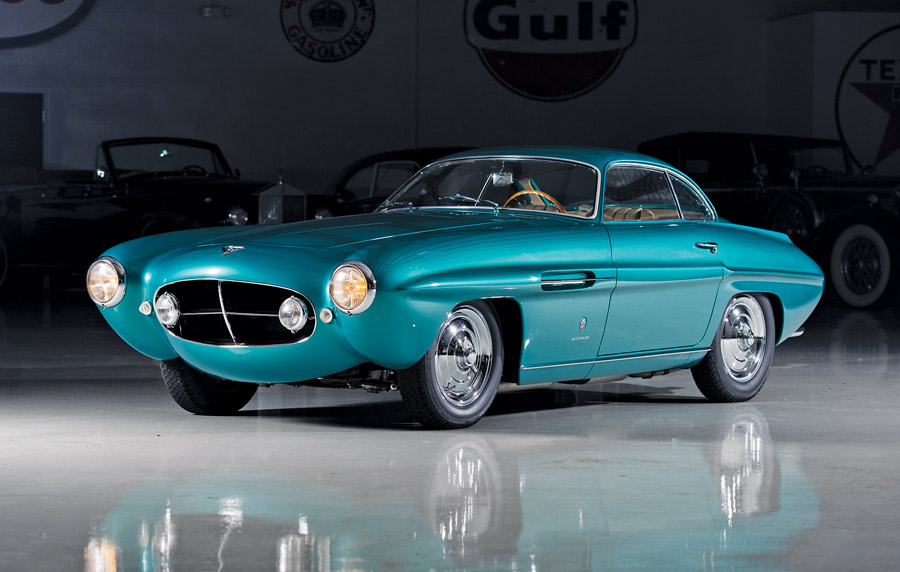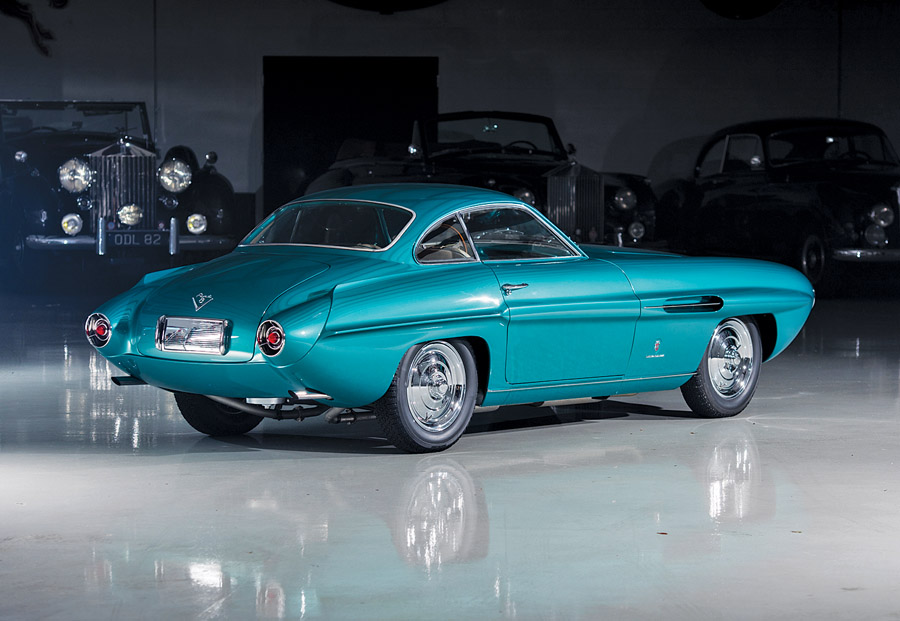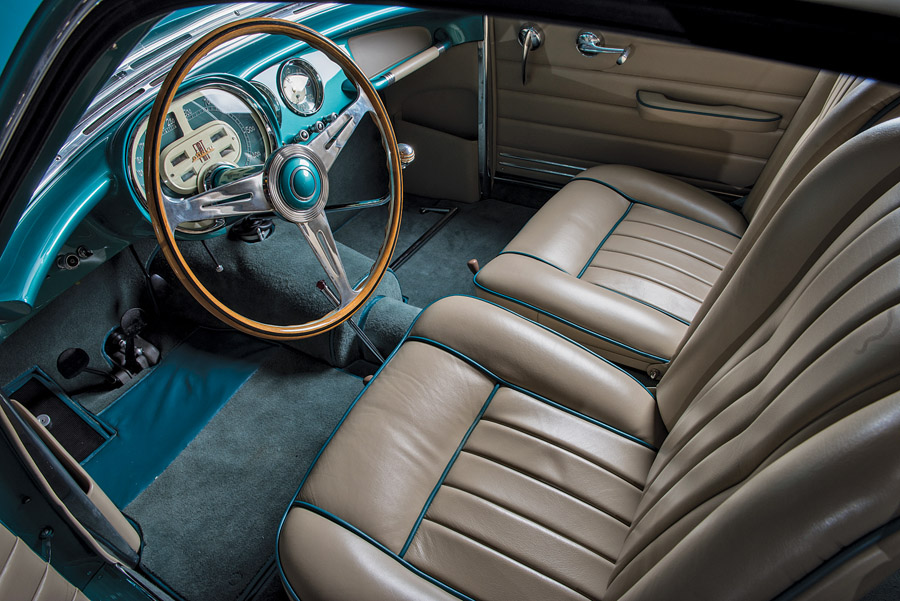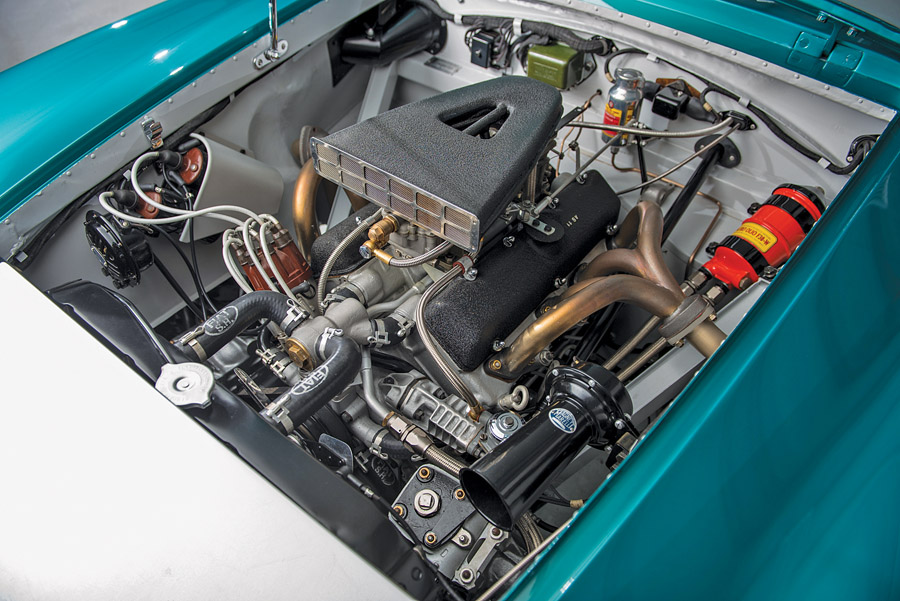Fiat’s most legendary, significant, and storied production model, the 8V, was aptly described in Road & Track in 1952 as “the biggest surprise of the year.” It came as a shock to the automotive world when Fiat suddenly introduced a powerful sports car with an advanced overhead-valve, light-alloy V8 engine, Siata-fabricated chassis and four-wheel independent suspension, which could be — and was — successfully raced by privateers all over the world.
Like most sophisticated chassis of the time, the 8V lent itself handsomely to custom coachwork, which Fiat encouraged.
Carrozzeria Ghia of Torino accounted for approximately 30 to 40 of the 114 8V chassis built, of which the most striking were the 15 bodied to Giovanni Savonuzzi’s stunning Jet Age design, known, simply and appropriately, as the Supersonic.
The Supersonic design had originally been proposed for an Alfa Romeo racing car, which Savonuzzi gave a steeply raked, long windshield; a curved nose that formed a straight-through beltline, ending at small tailfins flaring off lights intended to resemble jet afterburners; and a low, glassy greenhouse. Similar styling on an 8V chassis was subsequently ordered by American designer Paul Farago, and 14 more copies followed, all of which had detail differences but remained largely true to Savonuzzi’s original and dramatic design. They are considered the most sought-after and desirable 8Vs, as they boast the best combination of avant-garde design from the Jet Age.
Winner of the People’s Choice Award at the Amelia Island Concours d’Elegance and judged Most Unique at Classic Sports Sunday at Mar-a-Lago in 2016, it remains spectacular, fresh and ready for continued appearances at further national and international concours d’elegance. Alternatively, it is ready for participation in the Mille Miglia Storica, Colorado Grand or any number of other historic rallies for which such a significant automobile is always eligible.
SCM Analysis
Detailing
| Vehicle: | 1953 Fiat 8V Supersonic by Ghia |
| Years Produced: | 1953–55 |
| Number Produced: | 15 (114 total 8Vs) |
| Original List Price: | $11,000 (approximate) |
| SCM Valuation: | $1,100,200 |
| Tune Up Cost: | $600 to $800 |
| Distributor Caps: | $875 |
| Chassis Number Location: | Stamped on firewall and on chassis plate |
| Engine Number Location: | Stamped on cylinder block, distributor side on boss |
| Club Info: | Alfa Romeo Owner’s Club |
| Website: | http://www.aroc-usa.org |
| Alternatives: | 1954 Maserati A6G2000 coupe, 1953 Siata 208 coupe, 1955 Alfa Romeo 1900SZ, 1953 Ferrari 340 America Vignale coupe |
| Investment Grade: | B |
This car, Lot 122, sold for $1,375,000, including buyer’s premium, at RM Sotheby’s “A Gentleman’s Collection: The Pride & Passion of Orin Smith” Amelia Island, FL, auction on March 10, 2017.
One of my most prized possessions is a gouache illustration of the factory-bodied First Series Fiat 8V. Fabio Luigi Rapi, the designer, drew the illustration. Rapi’s design was very much a development of the pre-war aerodynamic style, with bold Art Deco detailing on a smooth, very rounded shape.
As was the custom of the time, however, other stylists and coachbuilders took their turns clothing the exciting new Fiat sports GT. Arguably, the 8V’s sporting reputation stands on the Zagato examples, which had the requisite lightness to make the most of the power from the 2-liter engine.
The most dramatic of all the bodies was the brilliant Giovanni Savonuzzi’s Supersonic for Carrozzeria Ghia. Savonuzzi was a well-trained and creative man. Through his extensive work and study of aerodynamics, Savonuzzi brought a very special and practical approach to both style and performance.
His portfolio is a fascinating and varied one — from the 1947 Cisitalia 202 CMM Aerodinamica Coupe with its large rear stabilizing fins — which is the source of one the most admired post-war Italian designs, the Cisitalia 202 Gran Sport — to the Ghia Supersonic X “Gilda” and the DeSoto Adventurer II.
Through his association with Chrysler at Ghia, he later worked for the Detroit company from 1957 to 1969 on their turbine program, doing much of the design and development work — but not the styling — on the 1964 Chrysler Turbine Car.
Savonuzzi’s design for the Supersonic was one of the most literal expressions of the “jet fighter for the road” theme. The bulging sides give a real fuselage look to the car, along with its very low cockpit-style roofline. The finishing touch are the twin “exhaust” taillights, which look for all the world like the tail end of the F-86 and F-100 Sabre and Super Sabre jets.
That the 8V Supersonic presented a bit of a problem for Fiat is interesting. The company management didn’t want to build a race car from the beginning. The “skunk works” project that created the 8V out of the view of the executive suite got just far enough to allow the small production to be sold to privateers, whose potential failures could be held at arm’s distance. That the Zagato cars did respectfully, as did the associated 8V-powered Siatas, was fine.
The Supersonic, however, looked like a glamorous, opera-going GT.
No surprise then that the majority of the 17 cars ended up in the United States — a country where Fiat didn’t officially offer the model for sale.
A fragile engine
Tony Adriaensens’ magnificent two-volume book, Otto Vu, contains the story of what I think is one of the most hysterical customer-service exchanges in automotive history. Henry S. Lauve was a chief designer in the interiors department at GM Styling who bought an 8V Supersonic from Ghia in 1953 at the Paris Auto Show. Soon after getting the car back to Detroit, he suffered an engine failure when a timing chain came loose and wreaked havoc.
Lauve wrote to Fiat, asking if his car had “an experimental engine” in it — and whether they might happen to have an engine “of recent design and more durable quality” as a replacement.
Fiat generously offered to replace his engine in exchange for his original — but also advised him that the 8V was “mainly destined to those sportsmen who wish to use them in the numerous road races which take place in Italy.”
And further, that he was apparently fooled by “(the) Ghia bodywork, which is one of luxury… practically leads the car to be put into (a) use different from the one planned by us.” In other words, you wanted todrive your car?
The reliability of the 8V engine has been much improved with study and practice, and it’s entirely reasonable to drive one today.
Back together and welcome everywhere
In a market where usability — of whatever sort — drives value, our example is an interesting one. Its fully known history is fascinating. Quite luckily, it survived Lou Fageol’s personalization and even found its original engine. It has already had its Norma Desmond comeback moments — at a leading international concours.
Mr. Smith bought this stunning car in August 2015 at Bonhams’ Carmel Valley sale, where it was the catalog cover lot. Estimated at $1.8m to $2.4m, it sold with buyer’s commission for $1.815 million (SCM# 266023).
That it sold here all-in at $1.375 million against a no-reserve estimate of $1.6m to $1.9m doesn’t mean the market for the 8V has somehow collapsed. This is a car for the show field, especially with its very distinctive, love-it-or-hate-it color. I happen to love it, but it still wouldn’t be my first choice for a Supersonic. Nonetheless, it’s welcome anywhere the new owner chooses to take it, and he or she has joined a very exclusive club. I think they’ve grabbed a great deal. ♦
(Introductory description courtesy of RM Sotheby’s.)



